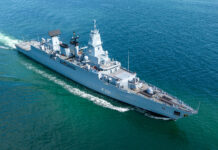The forces of US Central Command (CENTCOM) continue to strike at the offensive military assets of the Yemen-based Houthi militia in an attempt to curtail their ability to attack commercial shipping in the Red Sea region.
As well as targeting Houthi anti-ship missiles and bomb-laden unmanned aerial vehicles before they can be launched, on 17 February 2024 CENTCOM for the first time attacked what it described as an unmanned underwater vessel (UUV), which represents a new dimension to the threat to international shipping in the region.
The Iran-backed Houthis remain undeterred, however, with CENTCOM reporting that from 1315 hrs on 16 February to 0100 on 17 February (Sanaa time) the Houthis launched four anti-ship ballistic missiles into the Red Sea.
“It is assessed that three of the missiles were launched towards commercial vessel MT Pollux: a Panamanian-flagged, Denmark-owned, Panamanian-registered vessel. There were no reported injuries or damage from MT Pollux or any other ship in the area,” CENTCOM reported.
“Additionally, between the hours of 1:40 pm and 6:45 pm, CENTCOM successfully conducted two self-defense strikes against one mobile anti-ship cruise missile and one mobile unmanned surface vessel (USV) in Yemen. CENTCOM identified the mobile missile and USV in Houthi-controlled areas of Yemen and determined it presented an imminent threat to US Navy ships and merchant vessels in the region.”
On 19 February, meanwhile, the UK Maritime Trade Operations (UKMTO) agency reported that the crew of the Belize-flagged, British-registered cargo vessel Rubymar had abandoned ship off Yemen after it was hit by missiles fired by the Houthis. The ship was in the Gulf of Aden and nearing the Bab al-Mandab Strait when it was struck, according to security firms operating in the area.
On 18 February the UKMTO had reported that the master of a ship assumed to be Rubymar had reported “an explosion in close proximity to the vessel resulting in damage”.
According to BBC reporting, the security firm responsible for Rubymar, LSS Sapu, and data provider Lloyd’s List Intelligence confirmed that the ship had sustained damage after being hit by two missiles.
The potential loss of Rubymar, which according to the UKMTO was left at anchor, only serves to demonstrate that the Houthis’ capacity to do real damage to shipping continues despite the strikes against Houthis assets by US forces and occasionally UK Royal Air Force (RAF) Typhoon combat aircraft flying out of RAF Akrotiri on Cyprus. This is because the Houthis’ offensive capabilities continue to be replenished by Iran.
On 15 February CENTCOM reported that a US Coast Guard cutter forward deployed to the CENTCOM area of responsibility had seized advanced conventional weapons and other lethal aid originating in Iran and bound to Houthi-controlled areas of Yemen from a vessel in the Arabian Sea on 28 January.
“The US Coast Guard Sentinel-class fast-response cutter USCGC Clarence Sutphin Jr (WPC 1147), assigned to US Naval Forces Central Command, located the vessel and boarded it in the Arabian Sea,” CENTCOM reported. “The boarding team discovered over 200 packages that contained medium-range ballistic missile components, explosives, unmanned underwater/surface vehicle (UUV/USV) components, military-grade communication and network equipment, anti-tank guided missile launcher assemblies, and other military components.”
“This is yet another example of Iran’s malign activity in the region,” General Michael Erik Kurilla, CENTCOM commander, was reported as saying. “Their continued supply of advanced conventional weapons to the Houthis is in direct violation of international law and continues to undermine the safety of international shipping and the free flow of commerce.”












